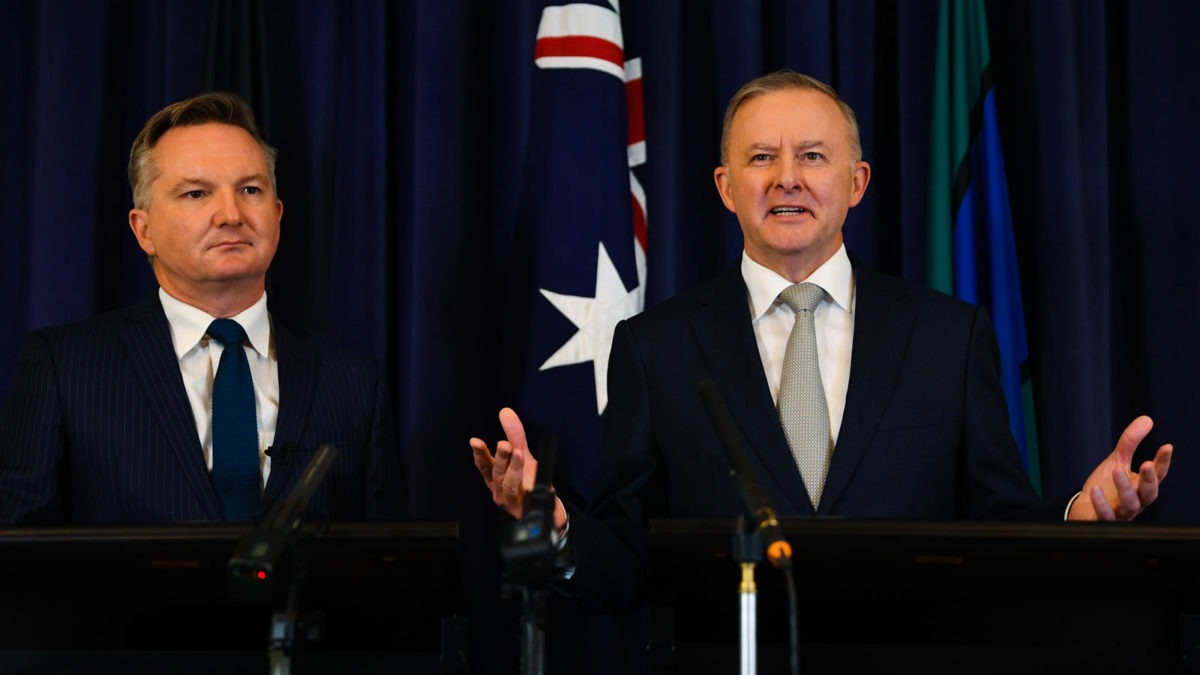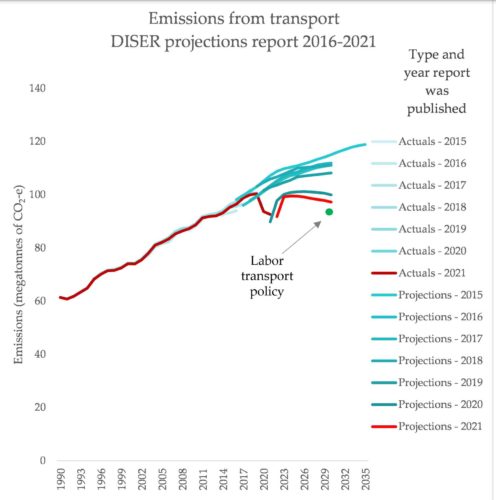Within the psychic space of Australia’s centrist climate commentators, there is an idea that the most serious ailment of climate policy has been partisanship. It is predicated on some truly ugly times – Tony Abbott’s brutal, destructive approach as a reaction to the strong ambition of the Gillard / Rudd years. A tall stack of Prime Ministers ripped from their perch by colleagues unnerved specifically by climate policies too likely to reduce emissions. The phrase “climate wars” has become a negative descriptor of pointless and endless squabbles about climate policy that delay real, bipartisan action to solve the problem.
It’s a ridiculously outdated framework for understanding Australian climate politics. The Morrison government released its ‘net zero by 2050’ plan a few weeks ago, and this week, the opposition leader Anthony Albanese released the roadmap to their revised 2030 target, the ‘Powering Australia’ plan. There is true, solid bipartisanship between the two major parties at the moment – both are equally committed to doing nowhere near enough on domestic emissions, and nothing but a worsening of exported fossil emissions through the expansion of coal and gas mining.
Both are deeply reflective of the heart of both parties, on climate and energy. The Morrison government’s plan is a scrawled, embarrassing mess. It is very literally the absence of climate policies, with some anxiously barked declarations about technology designed to cover up the yawning void.
And the Labor party’s newly released policy is a brilliant renewable energy plan wrapped in a genuinely terrible broader climate plan. Both parties insist that Australia will continue to export fossil fuels well into the future, and nervously gloss over the substantial emissions that stem from that domestically, during extraction and processing. Of course, both ignore the emissions when those fuels are burned overseas. Both parties accept donations from fossil fuel companies, both are fine with renewable energy but nervous about shutting down coal and gas power, and most importantly, neither have published plans to align Australia’s emissions trajectory with the goals of the Paris climate agreement – limiting warming to 1.5 degrees of heating above pre-industrial times.
The never-changing targets of the Liberal and Labor parties
Labor’s plan stands out between the two for being the worst missed opportunity. The ultimate goal of the plan is to reduce Australia’s emissions by 43%, by the year 2030, relative to 2005 levels. This is 2% weaker than the target Bill Shorten took to the 2019 election, which was 45%. That 45% was announced just over six full years ago, before the COP21 Paris climate conference, at which the global agreement was created, and it was based off the weakest possible end of the recommendations of the Climate Change Authority.
Labor only set their 45% target a couple of months after Tony Abbott and Greg Hunt announced their 26% targets, in 2015. While the Liberal party has refused to update or upgrade its 2030 targets, Labor is unique in having slightly weakened their 2015 era target.
"Labor pledges 45% emissions cuts by 2030, but the science says more is needed"
(from November 2015)https://t.co/mEVZGWklGu pic.twitter.com/0NYWlDAW0K
— Ketan Joshi (@KetanJ0) December 3, 2021
Reading the modelling underlying Labor’s plan, the reasons for this stand out very clearly. Some electricity sector interventions will push the penetration of renewables up to the low 80% by 2030, which is great. A framework for transmission networks, and two excellent community-focused policies (one for community batteries and one for ‘shared solar banks’ to bring clean power to apartment renters, like me) result in a drop in the electricity sector of 37 megatonnes of CO2-e by 2030, relative to the ‘baseline’ projected emissions released recently.
But that’s about where the good policy stops. In the transport sector, the reduction from the projected baseline is measly: only 4 megatonnes lower than the projected 97, in 2030. That’s because policies like combustion engine phaseout targets were never considered, and a fuel emissions standard was recently dropped. Labor’s plan brings Australia’s transport emissions to roughly what they were in 2014 (93 MTCO2-e). The pandemic cut around 10 MTCO2-e from projected 2030 transport emissions – surely Labor’s transport policy can do better than COVID19 at reducing emissions.
The Safeguard Mechanism is all loophole
In industry, the problems keep expanding. A scheme to allow polluters to earn ‘credits’ when their emissions are under a ‘baseline’ features in the plan. As Reputex recently wrote at RenewEconomy, “the crediting of emissions intensity improvements raises considerable additionality risks, with crediting to potentially reward ‘anyway’ projects for investment that does not represent additional abatement”. That is, the same Reputex that published Labor’s modelling! The risk of abuse of this scheme where not only do polluters get paid for contiuining to emit, but they also create
This chart from Santos' 2021 'climate report' is a perfect illustration of how the dodgy 'safeguard mechanism' adjusts emissions "limits" upwards as the country's worst polluters get even worse: https://t.co/epV4mKjQqI
(next step: they get carbon credits for this scam) pic.twitter.com/CIn12fl40o
— Ketan Joshi (@KetanJ0) November 3, 2021
The plan to ‘tighten’ the government’s existing ‘Safeguard mechanism’ will result, according to the modelling, in a substantial drop of 56 MTCO2-e. That’s more than transport and even electricity. It’s driven by an adjustment to the Coalition’s loophole-ridden Safeguard mechanism, under which emissions have increased for covered facilities, since its implementation. Labor’s plan simply takes the existing scheme and puts downward pressure on the currently too-high “baselines”, which in their modelling, reducing emissions.
This policy was proposed recently by the Business Council of Australia, and both the BCA and Labor mask the vagueness with the assertion that any gaps will be filled through the purchase of carbon offsets instead of real-world emissions reductions. Labor’s plan suggests one fifth of total abatement (40 MT) will come purely from offsets. None of the deep issues with offsets, including the temporary nature of biosequestration, are addressed in the plan. Allowing this loophole provides a continued incentive for businesses to avoid real, substantial short term emissions reductions.
Also problematic is how the scheme using “intensity” rather than absolute emissions, allowing for an increase in the latter with some clever accounting tricks.
Labor hasn't committed to capturing more businesses under the Safeguard as the BCA recommended…only to 'gradually' tighten pollution thresholds of businesses already in the scheme. Emitters may still be able to negotiate big increases in their emissions like they currently do.
— Polly Hemming (@pollyjhemming) December 3, 2021
The details shed so much light on why big business and industry are openly supportive of the plan. Being free to scribble out emissions using ultra-cheap offsets instead of real-world reductions is extremely popular among high polluters, at the moment. Corporate net zero plans are currently incredibly hollow shells that provide no downward force on emissions today, but serve as a tool for easing public pressure for companies to act on climate. Labor is leaning into this extremely troubled, loophole ridden system and doesn’t seem to be proposing any substantial reform.
It is incredible that Labor took their 2015-era climate ambition, and slightly weakened it. The numbers are very weird. Their 2019 plan was for 50% renewables, and a 45% cut in emissions. Their 2021 plan is for 82% renewables, but a 43% cut in emissions. Put simply: the massive increase in renewable potential, both through cost falls and Labor’s genuinely good policy ideas, has been cancelled out by allowing for greater emissions in transport, industry and presumably agriculture too; resulting in roughly the same total magnitude of reductions.
The justifications for this unjustifiable position abound, on Twitter. The general idea is that Labor needs to take a weak, fossil-friendly climate policy to the election to be elected, and once they’re in, they’ll aggressively ramp up the targets. Understanding why they haven’t upgraded their ambition since 2015 – when Obama was still president of the US – gives us a clue as to why this is unlikely.
Fundamentally, when you get past around 45 – 50% emissions reductions by 2030, you can’t rely heavily on offsets anymore. You don’t have the distant horizon of 2050, and you are stuck actually reducing emissions from Australia’s worst polluters: emissions-intensive coal plants, the coal and gas mining industries, and agriculture. If Labor were to be elected, nothing fundamental about why they refuse to raise their ambition would change. It has been this way for six years. Why would it change in 2022?
Actual, strong and immediate change is not what Labor, the Liberal party or Australia’s worst corporate polluters (who donate heavily to both parties) want to see. The Labor party could have announced genuine broader ambition to go along with their renewable energy policy. Both major parties seem to be permanently frozen in time. How long can this last?
Lies, myths and greenwashing. Good independent journalism is time-consuming and costly. But small independent media sites like RenewEconomy have been excluded from the tens of millions of dollars being handed out to big media companies from the social media giants. To enable us to continue to hold government and business to account, to cut through the lies and the misinformation about the renewable transition, and to help expand our work, you can make a voluntary donation here to help ensure we can continue to offer the service free of charge and to as wide an audience as possible. Thank you for your support.











